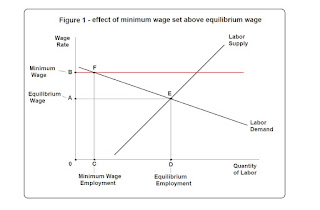Minimum Wage Increases Mandated by Government Are Lose-Lose-Lose for Workers
First watch this
short video: Is Raising the Minimum Wage
a Bad Idea?
https://www.youtube.com/watch?v=9aCpaON5NyE
…
Most economists believe the demand for
labor is elastic, with a relatively horizontal labor demand curve, as in Figure
1.
This
means
-a
1% increase in wages
-causes
a more than 1% number of workers not demanded by employers
With
natural free-market equilibrium wage A, total wages earned by all minimum wage workers
is the square area AED0.
After
the newly government-mandated higher minimum wage B, employment falls to C,
total wages earned falls to BFC0.
…
Lose
#1
The
minimum wage increase from wage A to wage B, results in
-a
decrease in number of minimum wage workers employed, moving from D to C
At
higher minimum wage B they are largely replaced with:
-higher
value workers including college students, retirees, and housewives who before
thought the free-market minimum wage too low to get a job
-increased
automation, previously more expensive than the minimum wage
…
Lose
#2
A
decrease in total wages for those who remain employed at new higher minimum wage,
moving from large area AED0 to small area BFC0.
…
Lose
#3:
Prices go up to cover the new higher minimum wage cost.
Wage costs are about 75% of a typical company’s total
costs.
Higher prices hurt low-income people the most.
…
All these are why
politicians avoid mandating big minimum wage increases, such as from wage A to wage
B.
With any minimum wage increase
there is some loss of jobs and total wages.
But with a small minimum
wage increase, it seems it is a gain for workers, because:
·
those who get
the new higher minimum wage get the most attention
·
many of the
unemployed are hidden because they never get a job in the first place
…
There is a possible additional
Lose #4:
A
minimum wage
can act as a ceiling on wages, keeping wages lower than they would be if there
was no minimum wage law:
·
employer knows new worker is actually worth $12 per hour, more than minimum
wage $10
·
but the new worker expects and accepts the $10 minimum wage
·
workers become comfortable with the workplace and do not look around for a job
that pays the $12 they are worth
·
because employers know they can hire $12 value people at $10, job wage level and
mobility are decreased
…
Perhaps
the only benefit of a mandated higher minimum wage is
a
large group of people, those don’t understand or accept the above information,
get a satisfying feeling government cares and is trying to do
something to help them.
As
California governor Jerry Brown said, “increasing the minimum wage to $15 is
the moral thing to do, but economically it might not make sense.”
Politicians’
pushing for a higher minimum wage can help maintain current political stability
and garner votes for those politicians.
Many
people become more satisfied with the “we care” government, at costs of
-slowed
economic growth
-increased
unemployment
-lower
total wages for low wage workers
-increased
government-dependency
-increased future political instability, with many people then again pressing for government to “do more to help.”



Comments
Post a Comment